Sunday, November 26, 2006
John's Tunafish Sandwich
Forget the Croissanwich–ham , turkey, cheese, tuna or chicken salad on a supersized refrigerated croissant is of course a purely American invention- the sandwiches the French do eat are usually served on baguettes and are fairly straightforward . The sandwich jambon beurre, that café staple, is usually made with half a of a very fresh baguette, liberally spread with soft butter and simply layered with ham.
If the French eat something a little more complicated that is served between two slices of bread it is something like the pan bagnat.
The classic pan bagnat is a close relative of the salade nicoise, and is made with a round pain de campagne, which is cut and half, with much of the interior crumb removed. Some recipes call for soaking the crumb with olive oil or a simple vinaigrette and mixing it with the other elements of the sandwich to form a kind of picnic loaf or bread bowl.
Like the salade nicoise, there are no two pan bagnats that are completely alike-some versions contain anchovies or sardines, some are made with tuna, some have raw bell peppers, some have roasted, some are made with a vinaigrette and some with straight olive oil. But a few ingredients are constant in all of them-bread, hard boiled eggs, olives, olive oil, tomatoes and some sort of prepared fish.
A few years ago I dined at Les Olivades in Paris, where every dish in the provencal repertoire was rethought and transformed -the lavender crème brulee was served in a terra cotta dish and the potato puree accompanying the lamb daube heightened with crème fraiche. The chef’s play on pan bagnat was to turn it into a sort of tartine: he toasted a long slice of baguette and covered it with a layer of arugula , then a layer of shaved fennel and fresh pimento (both marinated in a mixture of sherry vinegar and tomato juice ), then hardboiled eggs , then nicoise olives, and finally a few thin slices of rare tuna crusted in herbes de provence.
This version is best made with a fresh baguette. The bread is toasted and brushed with mayonnaise; the roasted peppers are marinated to add another dimension and the eggs are cooked just short of hardboiled to give them a little creaminess, sliced with an egg slicer (you can buy one for a few bucks at the supermarket) and showered with salt and fresh pepper. The tuna, a good quality oliveoil-poached, is further seasoned. The greens are tossed with olive oil and good balsamic vinegar.
NOTES:
- For the tuna , Ortiz oil packed Tuna is the best , or if you can find a good piece of fresh albacore or have the tail or "chain" from a loin of sushi-grade Tuna, poach the fish in oil yourself. The tuna should be submerged in oil ,baked at a low temperature until it’s cooked through and cooled in the oil. A cooked quality oil poached tuna has a fresh flavor and a moist texture. Poor quality tuna tastes fishy and sticks to your teeth.
- If you have some leaves of fresh basil, by all means add it to the arugula salad.
Saturday, November 05, 2005
A French approach to the hamburger
Typical French snobbery , right? We have the best and most innovative chefs and dishes in the world right now! Thomas Keller with his Butter- Poached Lobster! Mario Batali and his Fennel Pollen- Dusted Sweetbreads! Wylie Dufresne and his Foie Gras Terrine …with White Anchovies! As a matter of fact we even sent Alice Waters to Paris to teach those Frogs how to grow and cook organic! How dare they!
But the minette had a point. The burger is, inescapably, our national dish the way Couscous is the national dish of Morocco and Tunisia and Paella that of Spain.
Gumbo is certainly the most unique, deeply flavored and complex dish to come out of America (link)and a good clam chowder is unbeatable ,but these are both regional creations. A serious case could be made for barbecue , which is original to this country and has its advocates , who are often as loony and pedantic as Civil War reenactors, but again ( and the comparison should be a tip-off) it is really a dish native to those states that lost the War of Northern Aggression.
Everyone in this country eats hamburgers , though. Even vegetarians , the poor things, consume them in the form of veggie burgers or soy burgers or whatever combination of textured vegetable protein and nuts, mushrooms and sawdust they are made of. They’re the center piece of picnics and grills , the lifeblood of fast food ,and a feature of every vaguely American restaurant ,even the finest white tablecloth joint. The ’21 ‘ Club in
New York sports ‘the ‘21’burger with choice of potatoes’- for $30!
If this is true , then why is it so hard to get a good hamburger in America?
The fact is,in a restaurant a burger gets more abuse than a road-gang convict. In a fast-food joint or a bar kitchen it sits in a pool of its own blood for days or is flung right out of the freezer and-clack!-onto the griddle, where the cook smashes it with the bottom of his spatula , flattens it with a weight to cook it faster., and slaps it on a puffy , oversize bun.
And in finer restaurants it’s not much better. The quality of meat and garnish might be superior to the humble demotic kitchen and the price tag higher, but still…
In my own restaurant, you could tell when a customer ordered a burger by sound alone; by the extra hard slam of the refrigerator door and the extra hard slap of the meat on the cutting board. Trained cooks, especially cooking school graduates, usually hate cooking hamburgers and will put as little care as possible into their execution.Along with their names on their school-issue chefs jackets, it might as well say-‘I went to cooking school , so I don’t cook burgers.’
So what’s the solution? A French approach to cooking the hamburger. By that , I don’t mean butter-basting it and serving it with celeriac puree or Sauce Perigord , nor do I suggest stuffing it with foie gras and short ribs and serving it with pommes soufflés,as Daniel Boulud does.
By a French approach I mean internalizing a certain French attitude, that of the rigorous purist who takes pride in his cultural heritage, who employs the exactitude of the academie francaise grammarian, the unbending watchfulness of the douanier and the sensual precision of the affineur.
France , after all , is a country that has mandated by law the ingredients in a baguette.
Therefore , I propose the following strict guidelines for making a good hamburger which I hope one day to see passed into law:
A burger is composed of only fresh ground chuck ,salt and pepper:
A little olive oil on the outside is permitted, but if it the burger is seasoned with dried herbs, Cajun seasoning, Lawry’s seasoned salt, or is cut with milk, buttermilk, onions, garlic, teriyaki sauce ,breadcrumbs, tomato juice, White Zinfandel, Cabernet Sauvignon , or bbq sauce , it’s a patty or swiss steak or Salisbury steak or a meatloaf ,but it’s not a hamburger.
A burger is cooked to between 115 and 130 degrees internal temperature
A burger beyond medium is prison food.
We were astonished to see, on the Food Network’s Build a Better Burger Contest, that only one of the finalist cooked her burgers below well done. No wonder they needed all that filler.
A burger is about 6-7 ounces in weight and 1-1/2” to 2’ high before cooking
A thinner , smaller hamburger will inevitably overcook .
A burger is not exactly fast food
A burger is best if it comes to room temperature before cooking , is cooked over medium, not super high heat and is allowed to rest in a warm place for half of its cooking time before serving. This whole process might take as long as an hour.
There should be an equal proportion by volume of bread to meat
Bread is cheap and meat is expensive. A burger should not be a tiny patty of meat on a huge puffy bun. The bread should be roughly the size of the cooked patty and the combined height of the two pieces of bread should equal the height of the cooked patty.
A burger is not a piece of carbonized meat
Those tv shots of grilled food enveloped in orange flame look exciting but the truth is that the grill should touch the meat as little as possible. As Gary Danko says, when the flame touches the meat, that’s carbonization. I prefer my burgers sautéed., and will turn them three or four times during cooking so they get gentle caramelization.
Friday, December 17, 2004
SANTA FE
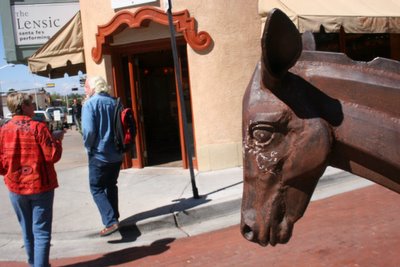
Most people, at least among the college-educated set, seemed to have rebel attitudes and social-climbing attitudes all scrambled together. Defying expectations and maybe logic, people [seem] to have combined the coutercultural sixties and the achieving
Eighties into one social ethos…The members of the new information elite are bourgeois bohemians..they are Bobos.
David Brooks, Bobos in Paradise
The house we’re staying in, an Architectural Digest-quality adobe colossus, sits at the end of a curving driveway thronged with deergrass, sagebrush and miniature sunflowers.
In a characteristic gesture, its owner has planted a cast- iron Buddha, prettily rusted, in the flowerbed below the house and has dropped a cheap floormat with the words ‘Wipe Your Paws’ near the front door, as if to show that he is simultaneously the possessor of great worldly success and too unpretentious and spiritual to care that much about it.
We’re admiring a newly acquired poolside table, a 12- foot slab of dark oak inlayed with carbon steel, when the owner, a walrus-mustache wearing consumer -rights lawyer, says those words heard so many times in this city: “We’re looking to open a gallery.”
Galleries: downtown Santa Fe has probably more of them per block than any other city in the world, from the lower- end side street tchotchke shops selling indigenous trinkets to the cool sanctora offering Ansel Adams originals for 250 grand a pop. The galleries seem the perfect institution to satisfy its clients’ need for the spiritual, the indigenous, the artistic and the material.
Even the first restaurant we visit, Café Pasqual’s, has its own gallery, displaying jewelry, traditional- type cookware, and Oaxacan Chagall pastiches.
Our first meal is breakfast at Pasqual’s, and every dish we try is a variation on the theme of earthiness: fluffy whole wheat pancakes with maple syrup ,a rib- sticking tamale with squash and peanuts, barnyard chicken breast with caramelized onions and manchego on a toasted cornmeal chile bread ,. The only disappointing plate is a Huevos Rancheros served on a mound of watery black beans with flavorless, cold tortillas.
After lunch we stroll through the mostly over- fifty crowd in the square. It’s easy to see why Santa Fe has so much appeal for prosperous aging boomers: it offers a beehive of arts and crafts production whose presiding spirit is that senescent icon Georgia O’Keefe, and a colorful and unthreatening native culture. Its high desert landscape draws so much beauty from an arid climate, a feature which must be encouraging to boomers as they confront the growing dessication of old age.
The boomer’s mythopaeia was intuited by the shrewd chef/ entrepreneur Mark Miller, whose wildly popular Coyote Café cookbook is written in a twee storybook prose:
Unlike Beaver or Squirrel, Coyote has never been known for his industriousness. Instead he revels in being clever, and you can bet that if ever there was a schemer it‘s Coyote.
At Coyote’s hangout Coyote Café, we feel you can never have too much of a good thing, which is why our motto is simply, more Chiles.”
For dinner we decide to skip Coyote Café, where, according to a friend who once worked there, crafty Coyote cuts his salsas with number ten cans of diced tomatoes, and check out Ristra.
Between the burnished plutocrats talking loudly on their cellphones and the burly servers jostling each other in this tight space, there’s a lot of testosterone in the room. We wait half an hour past the time of our reservation at the newly expanded bar and sit down to a few appetizers: a gnocchi and veal dish and a fig and arugula salad with goat cheese. The dishes arrive with disconcerting speed. The gnocchi bowl is cauterizingly hot but the stew itself is lukewarm; the veal has been chopped, Campbell’s Soup style, rather than shredded, and there are only three gnocchi in the dish. The salad, cheap broadline-distributor greens with none of the peppery bite of really fresh arugula, is overdressed in a sweet, bland fig puree dressing, which is also drizzled around the edge of the plate;the greens are mixed with fried yucca, which tastes like nothing except the oil it was cooked in.
After sending back the gnocchi and getting the same dish, slightly warmer, but still with same three gnocchi, we call for the check and head back to Pasqual’s.
The restaurant has emptied out by the time we arrive, but our laid-back server, a rumpled man in his forties wearing a pair of high top sneakers, doesn’t rush us, and recommends an excellent, jammy Zinfandel to start. We try the Caesar salad, sprinkled with spiced pecans dusted with deeply flavored chamayo chile powder, a corn pudding( similar in texture and flavor to a spoon bread) and at our server’s recommendation, the Plato Supremo., The Plato Supremo is our first encounter with the Santa Fe buffet platter aesthetic:A plate overflowing with a variety of muddy- tasting starches, including a chile relleno, a beef taco, an enchilada, rice, and a tamale, all jammed together and nearly indistinguishable in flavor. The best thing on the plate is the garnish: a fresh scallion from the local farmer’s market. The problem with New Mexican food is that it is really Mexican food, and the high starch, low protein feature of Mexican food wears easily. This type of cuisine is better suited to marathon runners than the sedentary older clientele that consumes it. We pick at a coconut flan, beautiful looking, but lacking sweetness and a little overcooked, and leave.
A little discouraged, the next day we walk across the square to The Shed, a Santa
Fe institution. There’s a half- hour wait, and by the time we’re seated, we’re starving.
A flat Coke is not a good sign and an anemic skewer of grilled shrimp with cocktail sauce doesn’t improve things. We try a combination platter which is like the Plato Supremo at Pasqual’s, only cheaper: beans, iceberg lettuce and ethylene- gassed tomatoes, red chile pork coated in stale spices, and a taco that has turned soggy from sitting in the bean liquid.
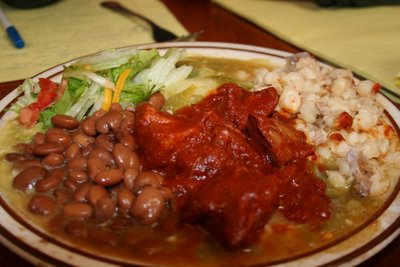
We pick at the plate, push it aside and decide to head over to the farmer’s market.
All the vitality that’s absent from the city’s restaurant scene is present at this extraordinary market , which is , on this flawless October afternoon, probably the best we’ve been to in this country.
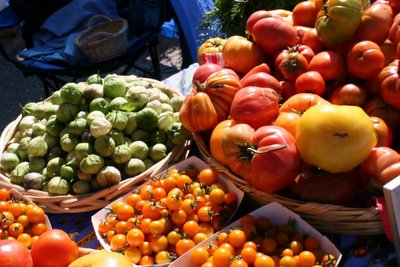
Our first stop is the Tierra Azul Farm stand. The market is winding down, but we’re so captivated by Layne Hartsell and Ann Peters, the couple who own the farm and run the stand, that we can’t tear ourselves away.
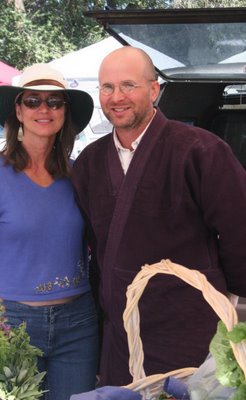
They’re so smart, funny –self-deprecating and full of radiant kindness that we spend a half an hour chatting with them. Layne is a self-styled renegade Buddhist monk and pamphleteer and Ann is a former anthropologist. This is their first year farming. They must find it hard, we inquire. No, Ann says with a smile, I’ve been growing things since I was a little girl. We buy some excellent mizuna, oyster mushrooms and squash blossoms and Layne suggests we check out Agua Santa, a small restaurant which buys their produce, for dinner.
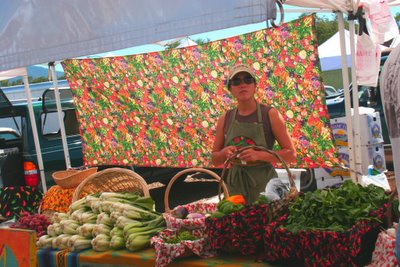
We stop by Shepherd’s Lamb, where Molly Manzanares is grilling lamb ribs on a
George Foreman grill. They are extraordinary , tender , juicy , spiked with a flavorful marinade made with garlic, sesame oil and mustard. We buy a bone-in leg of lamb and a bag of chicken wings from Pollo Real , which supplies Pasqual’s, among other places.
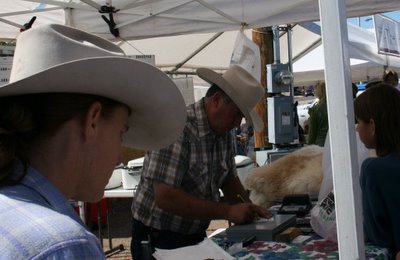
In a mood of almost frantic excitement as the market closes up,we make a few more purchases before we leave: lemon cucumbers, basil, cherry tomatoes, rosemary ,prune plums and some crisp, acidic Rome Beauty apples which we will poach the next day, roasted red and green New Mexico chiles , charred in the hand- cranked barrel chile roaster that is a feature of so many markets in the southwest.
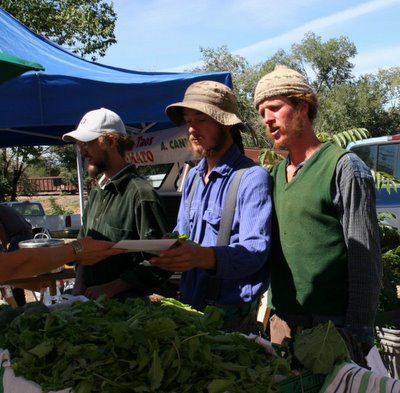
On our way back, we stop at Agua Santa, hoping to get some lunch, and find the restaurant closed and the chef-owner just back from the market.
We make reservations for that evening. It’s an elegant, quirky dining room, narrow bunker windows set in adobe walls, an open kitchen, floral china, a large country table laden with fruit and desserts, crates of vegetables lining the prep sinks that lead the way to the bathroom.
We watch the chef- owner, who is wearing a linen shirt and a dashing neckerchief, work the stoves while we scan the menu. The theme is Nouvelle Orleans, and we decide on a green salad with a sherry dressing, a sort of pizzetta with spicy rock shrimp, steamed mussels and scallops with parsley and garlic, and a duck breast with a sweet corn polenta and gypsy peppers.
The salad is impeccably fresh and perfectly dressed, the sort of thing most chefs should make well but seldom do. The pizzetta is aggressively seasoned, flavorful, but with a crust perhaps a little too thick for such an elegant restaurant.
The seafood stew is, surprisingly in this landlocked state, fresh- tasting and the best thing we try.
The polenta, with its play of corn –on corn is delicious and complex and the peppers are market fresh, but the duck is slightly overcooked and lacks the big fresh flavors of the local ingredients on the plate.
For dessert we try a Peach Melba- style Panna Cotta, served with raspberry coulis and a
peach compote. Like a surgical boob job, this Panna Cotta doesn’t wiggle when we shake it and after trampolining our spoons off the top of it we take a few unenthusiastic bites and push it aside.
We call for the check. I’ve been eavesdropping on the conversation of two older women seated next to us. They’ve been having a typical Santa Fe tête-à-tête, chatting about the opera, Zen Buddhism, menopause, and real estate values. One of the women has been telling the other about her new Black Lab.: she details the long and undoubtedly expensive process of acquiring the dog: the interviews, background checks and references for the breeders; the anti-vivisection tattoo; the GPS chip. Are you happy with the dog? the friend asks. Yeah, the other woman answers; ‘he’s an old soul and he’s great with kids. And best of all,” she smiles and leans in for emphasis,” he looks just like a mutt.”
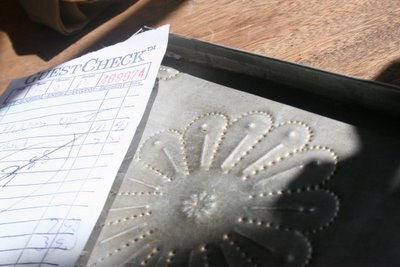
.
